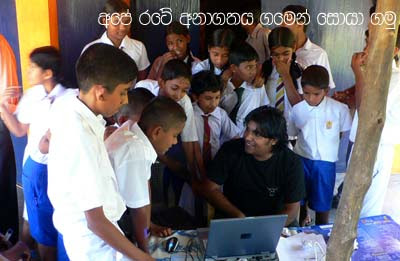Time : June 2008 to January 2009
By : Uva Regional Impact Team/ Shilpa Sayura Foundation
What : The approach and key strategies used to establish and ensure network communications to improve sustainability of the Uva Province Telecenter Network.
Introduction
E3 Network communication platform is a virtual communication infrastructure connecting Telecenter actors in Uva Province, Sri Lanka, expands Telecenter eco system involving users and supporting groups, a living digital organism to create and deliver messages among many to many linked network nodes, initiating network action for M & E, capacity building, Technical support, content and services, knowledge sharing, reporting and advocacy needs to develop Telecenter Network sustainability.

E3 connects key stakeholders direct or by way of indirect links and digital representation, keeps expanding and adding new actors, links to participative networks, change constantly, improves and re-shapes it self with new tools, content facilitated by Regional Impact Team (RIT).
In June 2008 on an assignment from ICTA, Project E3 initiated to help sustain 60 Telecenters in Uva province, Sri Lanka. The M & E found that lack of communication platform is one of the key issues challenging Telecenter sustainability. RIT first priority was to establish a strong communication network for enabling RIT to Telecenter, Telecenter to Telecenter, Telecenter to community, Telecenter to ICTA and Telecenter to Service Provider and vise versa and also needed linking with global ICT4D actors.
The biggest challenge was to establish a communications platform among 60 Telecenters when only 52% had access to internet. After 9 months of Network development, Uva Province Telecenter Network has emerged improving network sustainability as a result of E3 Telecenter network communication and development strategies.
Methods
ICT literacy should not be a barrier for initiating network communications started with letters to connect all Telecenters to RIT. assessed their needs using pocket workshops, discussed problems and found feasible solutions establishing the first form of contact. RIT developed a set of network communication strategies, protocols, formats for messages delivery and feedback.
E3 regional think tank involved Telecenter Operators initiating discussions and knowledge sharing for network strategy formulation which also helped inter Telecenter networking.
Different skill levels in communication required training on online communications, local language tools and training content. Use of local language in emails, forums, blogs, skype, ning social networks and online publishing of activity photos, feedback videos helped attracting Telecenter Community to the emerging tools that were part of strategic communications platform.
Use of effective tools and communication channels helped networking Telecenters, ICTA, Service providers, supporting actors which helped increasing sustainability activities in the network.
Shilpa Sayura like content helped Telecenters to establish relationships with their communities, training content improved Telecenter operation and created an online learning and knowledge share community in the E3 Telecenter network.
The continues local capacity building workshops helped improving inter actor communications, knowledge and resources sharing. Online advocacy motivated Uva Telecenter network to emerge as an E3 Telecenter Sustainability Network, receiving national and global ICT4D and Research attention for sustainability development.
Lessons learned
Effective network communication is essential for Telecenter sustainability, requires bottom up development and use of local languages, openness and effective communication tools. Involvement of network actors required to ensure a sense of ownership of the network.
Network messages require consideration of the appropriation of content, format and delivery methods. Postal mail is a useful as a network messaging strategy to involve non ICT literate network actors.
Chat, Skype conferencing, Mailing lists, online groups, ning like social networks, and blogs help initiating network actions and also effective in developing network communications.
Open communications help motivating small players to play big roles in the network. Informal communications are useful assessing effectiveness of network programs, help generating new ideas and online publishing of network activities and Telecenter experiences help share knowledge in the network.
Continues Telecenter training, knowledge sharing and PR events facilitation in local networks is essential to create an enabling environment for effective network communications.
Future challenge of Uva Telecenter network is to continuously maintain the E3 Network emergence ensuring using of effective network communication strategies and tools leading to network sustainability, requires a process to form the virtual E3 Uva Telecenter network to a more formidable entity to binding all actors in the E3 Telecenter Network.
Niranjan Meegammana
Uva RIT Services Team Leader
Project E3 - Shilpa Sayura Foundation
http://www.shilpasayura.org
